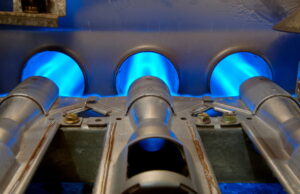Gas furnaces. They’re everywhere. Even with the influx of technology like heat pumps and ductless mini splits, gas furnaces still hold the title of the most common type of home heating system in the US. Gas furnaces wouldn’t be so popular if they created safety hazards, and all gas furnaces have several devices that help keep them running safely.
Today, we’re going to look at one of these key devices, the flame sensor. The flame sensor isn’t just a safety mechanism: it helps regular normal furnace operation and keeps the system working efficiently and evenly.
The Job of the Flame Sensor
The flame sensor plays a critical role in how your gas furnace operates. The sensor detects the presence of flames from the burners, which is to ensure that the burner lights properly. If the flame sensor doesn’t detect flames, it will shut off the gas valve and stop gas flow to the burner. This occurs to prevent unburned gas from flooding the combustion chamber of the furnace, where it presents a large combustion hazard that might escape into the areas around the furnace.
Older furnaces used a device called a thermocouple to detect flames. Most modern furnaces use the more accurate and reliable electronic flame sensor. If you have a furnace that still uses a thermocouple, the heating system is probably old enough that you should consider replacing it.
Signs of a Failing Flame Sensor
If the flame sensor is starting to fail because of dust or dirt, or it has failed because of an electric malfunction, you may notice several warning signs:
- Frequent cycling: If your furnace is turning on and off far more frequently than usual, it may be that the sensor is having trouble detecting flames.
- No heat output: If the sensor is completely broken or blocked, it may not allow the gas valve to open—and the furnace won’t provide any heat at all.
- Error code: Some modern furnaces are equipped with diagnostic features that display error codes. If you see an error related to the flame sensor, it’s time to investigate. Start by consulting the manual to see what the error code means.
Turn to HVAC Professionals
You may feel tempted to get inside your furnace, locate the flame sensor, and try to clean it. We don’t recommend taking this route, however. You can’t even be certain that the flame sensor is the problem, and tampering inside the furnace can create worse problems, potentially harmful ones. Instead, call for HVAC professionals like ours.
We’ll first inspect the furnace to see the source of the problem. If the issue is the flame sensor, we can handle whatever cleaning, repair, or replacement is necessary to fix it with our expert heating repair in Katy, TX. We’ll then test the furnace to ensure it is once again working safely and effectively.
Another fact to keep in mind: the best way to avoid the flame sensor from getting covered with dust and dirt is to schedule professional furnace maintenance each fall. Our technicians will clean the sensor when we tune-up the furnace.
At AC Comfort, your comfort is our business! Serving Katy, TX and the surrounding areas—call us today for heating service and more.


